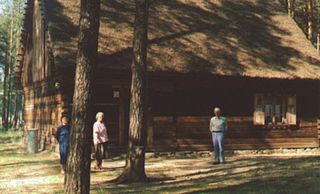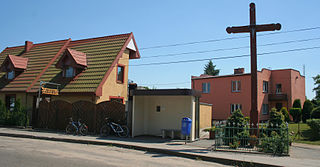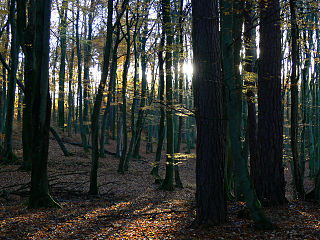A voivodeship or voivodate is the area administered by a voivode (governor) in several countries of central and eastern Europe. Voivodeships have existed since medieval times and the area of extent of voivodeship resembles that of a duchy in western medieval states, much as the title of voivode was equivalent to that of a duke. Other roughly equivalent titles and areas in medieval Eastern Europe included ban and banate.

The Piaśnica is a river in northern Poland, in Puck County near Gdańsk, in Pomeranian Voivodeship. It begins inside the Puszcza Darżlubska Wilderness, located in the northernmost part of the geographical region of Pobrzeże Kaszubskie. Darżlubie Forest contains two nature reserves. On the south–side it borders the Tricity Landscape Park from which, it is separated by the Reda river. The wilderness, is also the source of river Gizdepka. The name of Piaśnica comes from the nearby villages of Piaśnica Mała and Piaśnica Wielka.

Romincka Forest, also known as Krasny Les or Rominte Heath, is an extended forest and heath landscape stretching from the southeast of Russian Kaliningrad Oblast to the northeast of Polish Warmian-Masurian Voivodeship.
Gmina Tuchola is an urban-rural gmina in Tuchola County, Kuyavian-Pomeranian Voivodeship, in north-central Poland. Its seat is the town of Tuchola, which lies approximately 55 kilometres (34 mi) north of Bydgoszcz.

Kurpie is one of a number of ethnic regions in Poland, noted for its unique traditional customs, such as its own types of traditional costume, traditional dance and distinctive type of architecture and livelihoods. Kurpie is also the name of the people of this culture.

Trzebież is a village in the administrative district of Gmina Police, within Police County, West Pomeranian Voivodeship, in north-western Poland, close to the German border. It lies approximately 15 kilometres (9 mi) north of Police and 28 km (17 mi) north of the regional capital Szczecin.

Szczecin Landscape Park "Beech Woods" is a protected area in north-western Poland, established in 1981 and covering an area of 91 square kilometres (35 sq mi). Its full name refers to the dense forest known as Puszcza Bukowa, which covers most of the area of the Park.

Puszcza Biała is the name given to the forest that extends in Poland from Pułtusk to Ostrów Mazowiecka. It is part of the Mazovian lowlands and consists of small trees, mostly pine.

Puszcza Kurpiowska or Kurpiowska Forest, is the collective name of Poland's two wilderness areas: Puszcza Biała and Puszcza Zielona, located in the central basin of Narew and Kurpiowska Plain. It is bound by the rivers: Pisa (east), Narew (south) and Orzyc (west). The north-end reaches the border with Masuria.

Puszcza Zielona is a forest in Poland which extends from the Narew River and the border with the region of Masuria. It is bounded on the east by the Pisa River and on the west by the Orzyc River. The forest lies in a lowland and contains a wet sandy soil, but it is rich in various minerals which are mined.

Darżlubie is a village in the administrative district of Gmina Puck, within Puck County, Pomeranian Voivodeship, in northern Poland. It lies approximately 5 kilometres (3 mi) west of Puck and 43 km (27 mi) north-west of the regional capital Gdańsk.

Dobieszczyn is a settlement in the administrative district of Gmina Police, within Police County, West Pomeranian Voivodeship, in north-western Poland, close to the German border. It lies approximately 18 kilometres (11 mi) north-west of Police and 27 km (17 mi) north-west of the regional capital Szczecin.

Niekłończyca is a village in the administrative district of Gmina Police, within Police County, West Pomeranian Voivodeship, in north-western Poland, close to the German border. It lies approximately 10 kilometres (6 mi) north-west of Police and 23 km (14 mi) north of the regional capital Szczecin.

Uniemyśl is a village in the administrative district of Gmina Police, within Police County, West Pomeranian Voivodeship, in north-western Poland, close to the German border. It lies approximately 12 kilometres (7 mi) north of Police and 24 km (15 mi) north of the regional capital Szczecin.

Puszcza Piska Forest or the Pisz Forest is the largest forest complex of the Masuria region in northern Poland, adjacent to the Masurian Landscape Park, and the Masurian Lowlands. Formerly known as the Jańsborska wilderness, Puszcza Piska bears the name of the Pisa river bordering the Forest along its west bank.

Puszcza Darżlubska or Lasy Piaśnickie, located in the northernmost part of Poland, is a Polish forests complex on the Baltic Sea, within the geographical region of Pobrzeże Kaszubskie; on the south-side bordering the Tricity Landscape Park from which it is separated by the Reda river. Inside Darżlubie Forest there are two nature reserves. The wilderness is also the source of two rivers: Piaśnica and Gizdepka. The name of Puszcza Darżlubska comes from the nearby village of Darżlubie in the administrative district of Gmina Puck, north of Gdańsk.

State Forests[a] is a Polish governmental organization that manages state-owned Polish forests on behalf of the Polish State Treasury. The organization does not have a legal personality and is required to be financially self-sufficient.

Knyszyn Forest is a vast forest complex located in the Białystok Upland in the Podlaskie Voivodeship. The forests cover there areas of the frontal moraine, and the Supraśl River flows along the tributary of Sokołda. Supraśl is the seat of the Knyszyńska Forest Landscape Park.

Kurpie Białe is an ethnographic group of Polish people inhabiting the Puszcza Biała region in Mazovia.





















